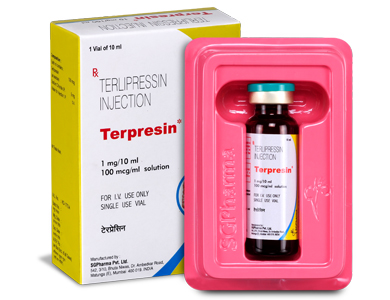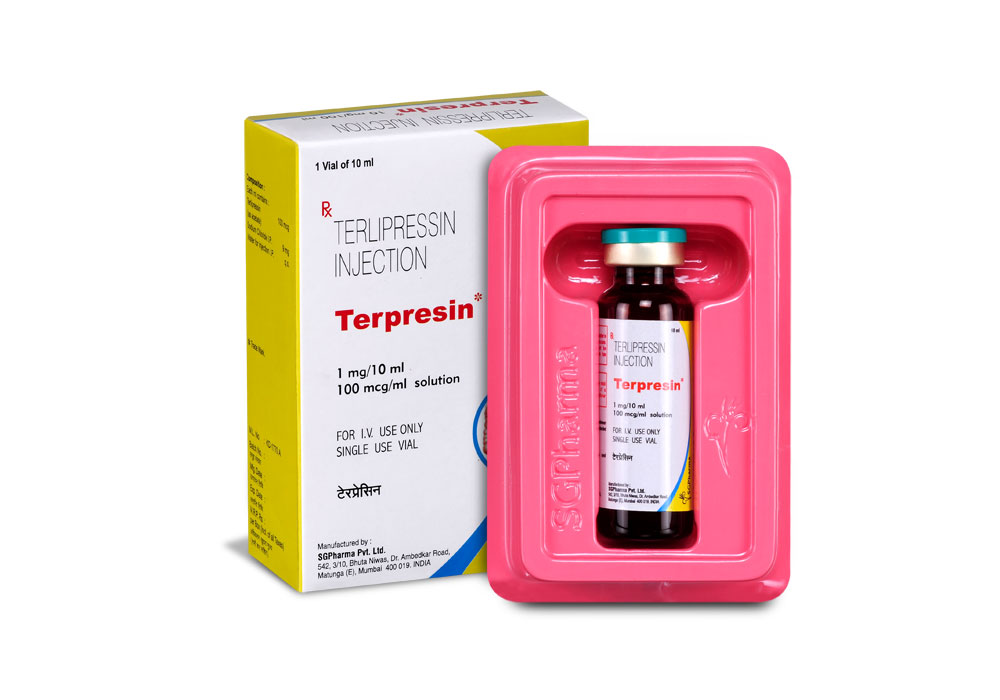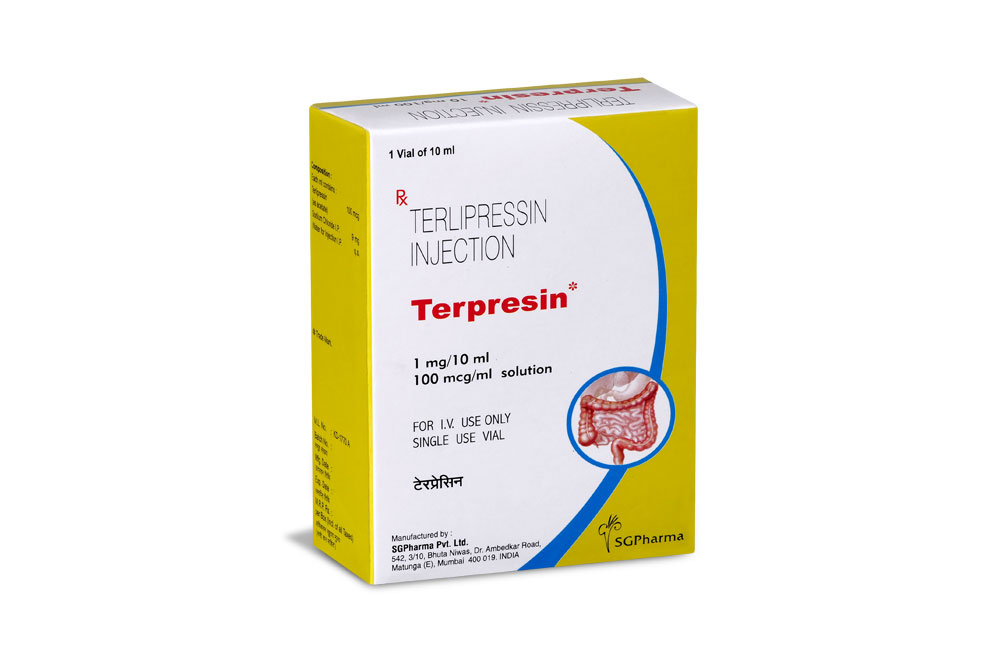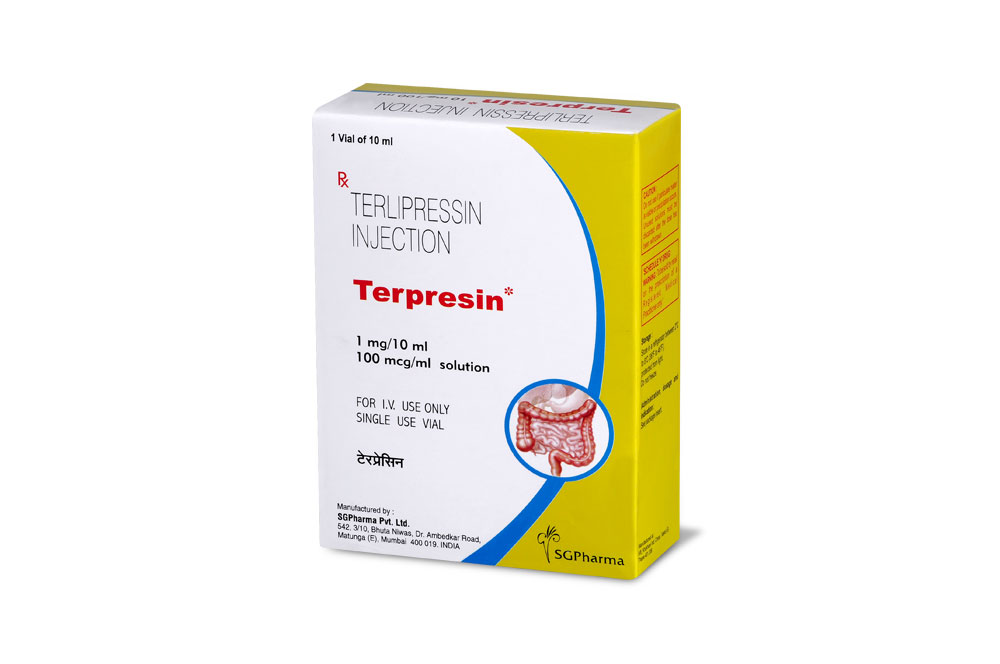
1 mg/10 ml
For the use of a Registered Medical Practitioner or a Hospital or a Institution only.
Terpresin (Terlipressin) is the synthetic, long-acting analogue of vasopressin. Chemically, Terlipressin is Nα-glycylglycylglycylvasopressin. The molecular formula is C52H74N16O15S2 and molecular weight is 1227.39.
STRUCTURAL FORMULA :
Its structural formula is :
Terpresin is a clear colourless solution filled in 10 ml amber glass vial.
COMPOSITION :
Each ml contains :
Terlipressin 100 mcg
(as acetate)
Sodium Chloride USP 9 mg
Water for Injection USP q.s.
ACTIONS :
Terlipressin may be regarded as a circulating depot of lysine vasopressin. Following intravenous injection, three glycyl moieties are enzymatically cleaved from the N-terminus to release lysine vasopressin. Terlipressin has significant vasoconstrictive and ntihaemorrhagic effect. The most significant change is reduced blood flow in splanchnic area with following reduction of hepatic blood flow and portal blood pressure. Pharmacodynamic studies have shown that like other similar peptides, terlipressin causes intraarteriolar, intravenous and intravenular constrictions primarily in splanchnic area as well as constriction of oesophageal unstripped muscles and increase in tonus and intestinal peristaltic activity. In addition to its vasopressor effects, terlipressin stimulates myometrial activity, even in nonpregnant uterus. The anti-shock effect of terlipressin has been confirmed not only for haemorrhagic but also for endotoxic and histaminic shocks. There are no clinical manifestations of the antidiruetic effect of terlipressin.
PHARMACOKINETICS :
Terlipressin as such is inactive in relation to smooth muscle but it serves as a chemical depot for active pharmacological substances formed by enzymatic cleavage process. Compared with lysine-vasopressin, the effect comes more slowly, however much longer.
Lysine-vasopressin is subject to usual biodegradation in liver, kidneys and other tissues. The intravenous pharmacological profile can be described using a two-compartment model. The excretion half-life is about 40 minutes, metabolic clearance about 9 ml/kg x min and distribution volume about 0.5 l/kg. Estimated lysine-vasopressin concentration can be found in plasma, 30 minutes after administration of terlipressin with peak values after 60 - 120 minutes.
INDICATIONS :
Bleeding in gastrointestinal and urogenital systems such as oesophageal varices, gastric and duodenal ulcerations, functional and similar types of metrorrhagia and in case of miscarriage or abortion and similar situation.Bleeding occurred as a result of operation, in particular those in the abdominal and pelvic area.Local application in gynecological operations, such as cervix porta uteri.
Administration :
Terpresin must only be administered intravenously.
Dosage :
Bleeding Oesophageal Varices :
Adults :
Initial bolus dose 2 mg should be administered by an intravenous bolus injection over one minute, followed by 1 mg - 2 mg every 4 - 6 hours for next 24 - 48 hours. For prevention of bleeding recurrence, continued medication shall be recommended, until the bleeding has been controlled. The dose shall be administered I.V. (as a rule bolus) injection or short-term infusion.
Children :
8 to 20 mcg/kg of body weight given at intervals of 4 - 8 hours.
Other types of gastrointestinal haemorrhagia :
1.0 mg (1000 mcg) every 4 - 6 hours can be used as first aid medication in cases of clinically suspected bleeding in upper part of gastrointestinal system.
Bleeding from the splanchnic region in children :
The usual dose ranges from 8 to 20 mcg/kg of body weight given at intervals of 4 - 8 hours. The administration of the dosage should be continued throughout the period of bleeding. The general dose recommendation is as in cases of bleeding in adults. For sclerotized oesophageal varices a single does of 20 mcg/kg body weight is given in bolus form.
Bleeding from the urogenital tract :
The dosage will range 0.2 - 1.0 mg (200 - 1000 µg) every 4 - 6 hours.
Juvenile Metrorrhagia :
For juvenile metrorrhagia, doses of 5 - 20 µg/kg of body weight are recommended. The administration should be intravenous.
Local application in gynaecological operations :
Add saline to 0.4 mg (400 mcg)dose to obtain 10 ml and apply intracervically or paracervically. The effects of such preparation can be seen after approximately 5-10 minutes. If necessary, increase or repeat the dose.
Hepatorenal syndrome :
1 - 2 mg twice daily as I.V. bolus for 2 - 4 weeks. Dose may be adjusted if required.
CONTRAINDICATIONS :
• First trimester of pregnancy
• Septic shock
WARNINGS :
In 2nd and 3rd trimester of pregnancies, the benefits against risk of administration always should be considered. Caution is advised when administering to elderly patients with ischemia, serious hypertension, cardiac arrhythmia or asthma bronchiole. When administering Terpresin especially in higher doses (0.8 mg = 800 µg and more), tight monitoring of blood pressure, heart rate and liquid balance is recommended. This is specially for patients with hypertension, heart insufficiency and elderly patients. Terpresin is not a replacement of blood substitution in patients with blood volume deficit. Regarding individual cases of local necrosis, reported after administration of terlipressin, an intramuscular administration of 0.5 mg (500 mcg) doses and more should be avoided. Intravenous administration is increasingly preferred.
PRECAUTIONS :
Pregnancy :
Terlipressin causes rise in myometrial activity and decrease in uteral blood flow. Reproduction studies in rabbits and rats with higher doses showed increased abortion rate or embryo deaths. In infants lower birth weight as well as increased anomaly rate has been found. Terlipressin is contraindicated in pregnancy.
Lactation :
Terlipressin distribution in breast milk is not available; however significant absorption of unchanged peptides in gastrointestinal system of child seems not to be probable. There is no definite data on terlipressin use in lactating women.
Paediatric use :
There is very limited clinical experience in children, caution to be exercised during use in this group of patients.
Geriatric use :
There is very limited clinical experience in elderly, caution to be exercised during use in this group of patients.
INTERACTIONS :
Both oxytocin and methylergometrine increase the vasoconstrictive and uterotonic effects. Terlipressin enhances the hypotensive effect of non-selective blockers in the portal vein. Concomitant medications with substances lowering heart rate can result in serious bradycardia.
INCOMPATIBILITIES :
Not known.
SIDE EFFECTS :
The most frequent effects in course of administration are : paleness, hypertension, abdominal pain, accelerated defecation or abdominal colics, nausea, diarrhoea and headache. In less frequent cases bradycardia has been reported. Serious adverse effects are rare. Individual cases of heart attack, heart failure, dyspnoea and local necrosis at injection place were also reported.
OVERDOSAGE :
The recommended dose (2 mg/4 hour) should not be exceeded since an exceeded dose increases the risk of serious effects on the systemic circulation.
TREATMENT OF OVERDOSAGE :
Increase in blood pressure in patients with known hypertension has been controlled with clonidine 150 µg I.V. Severe bradycardia should be treated with atropine.
PHARMACEUTICAL PRECAUTIONS :
Parenteral drug products should be inspected visually for particulate matter and discoloration prior to administration, whenever solution and container permit.
STORAGE :
Store in a refrigerator between 2°C to 8°C (36°F - 46°F), protected from light.
Do not freeze.
SHELF LIFE :
24 months from the date of manufacture.
PRESENTATION :
Terpresin is supplied as 1 mg Terlipressin (as acetate) in 10 ml aqueous solution.
Such one vial of 10 ml is packed in a Box.
Disclaimer : For the use of a Registered Medical Practitioner or a Hospital or a Institution only. Also it is not intended to be used by healthcare professionals or patients for the purpose of prescribing or administering these products. Questions regarding the complete and current content of product labeling / specification / presentation should be directed to SGPharma.

 Cardiovascular
Cardiovascular








